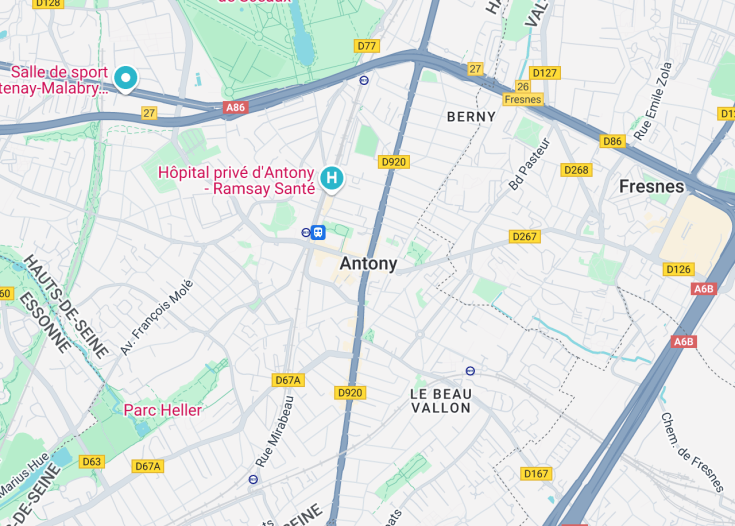Antony, a charming suburb of Paris, France, offers a serene escape from the bustling city life while still keeping the rich cultural heritage of the French capital within reach. This picturesque locale is known for its lush parks, impressive historical sites, and vibrant community events. Antony is an ideal destination for travelers seeking both relaxation and a taste of French urban culture, providing a unique blend that promises an enriching experience.
Before visiting Antony, be sure to check the local calendar for cultural festivals and events; these are perfect opportunities to experience the town’s lively spirit and hospitality.
Plan to spend an afternoon exploring the Parc de Sceaux. This grand park, complete with majestic château and sculpted gardens, offers a picturesque setting for leisurely walks and picnics.
Top things to do & see in Antony
Select the following sights and activities to discover best tickets and tours available in Antony.
Antony: A Suburban Gem near Paris
| Country | France |
| Time in Antony | GMT+1 |
| Language spoken | French |
| Population | 62,210 (Source: latest municipal report) |
| Currency | Euro (€, EUR) |
| Airports |
|
Antony, located in the southern suburbs of Paris, France, balances the charm of a quiet residential town with the bustle of a cosmopolitan hub. With a history dating back to the Roman era, the town has evolved significantly over the centuries. Today, Antony is appreciated for its rich architectural heritage, featuring a mix of ancient churches, modern buildings, and tranquil parks.
This town is not just about scenic views and historic sites; it’s a vibrant community with a strong emphasis on cultural activities. Antony hosts various festivals and events that bring together local artists, musicians, and performers. The town’s commitment to the arts can be seen in its well-funded libraries, cultural centers, and museums that promote learning and innovation.
Educationally, Antony boasts several reputed schools and is near some of France’s leading universities and research institutions. Economically, it benefits from its proximity to Paris, with many residents commuting to the capital for work. This proximity also makes Antony an ideal place for those seeking a quieter residential area while working in the bustling city of Paris.
The healthcare facilities in Antony are advanced, providing residents with top-notch medical care. Sports and recreational facilities are abundant, catering to all ages with well-maintained sports complexes and public parks.
Socially, Antony is a melting pot of cultures, largely due to its diverse population that includes people from various ethnic backgrounds. This diversity is celebrated through numerous community events that encourage social cohesion and mutual respect among residents.
Where is Antony?
Located just south of Paris, Antony stands out as a pivotal suburb in the Île-de-France region.
Distances:
| Route | Distance by car | Time by car |
|---|---|---|
| Paris to Antony | 8 miles (13 km) | 35 minutes |
| Versailles to Antony | 10 miles (16 km) | 25 minutes |
What is Antony famous for?
Antony is known for its peaceful residential life with easy access to Paris, mixed with vibrant cultural influences and frequent community events, fostering a dynamic and inclusive atmosphere.
History
Antony, a suburban commune in the southern suburbs of Paris, France, boasts a rich history that reflects the broader historical trends and upheavals in French history. The journey of this now bustling community from a humble settlement to a significant urban center offers an intriguing glimpse into France’s past and its evolving dynamics.
Prehistory to the Middle Ages (Before 10th Century)
The area of Antony was first inhabited in prehistoric times, as evidenced by archaeological finds indicating the presence of early human activities. However, Antony’s significant development began in the medieval era when it was a small agricultural settlement. During these times, it primarily revolved around a local manor and church, commonplace centers of life in medieval France.
The Middle Ages to the 17th Century (10th Century – 1700s)
Throughout the Middle Ages, Antony evolved under the influence of various noble families. The local church, the Church of Saint-Saturnin, originally built in the 12th century, was a pivotal landmark during this period. By the 17th century, Antony became known for its market and as a rest stop for travelers heading to and from Paris, contributing to its gradual growth.
18th Century to World War II (1700s – 1945)
The 18th century marked Antony’s development into a more significant settlement. Notably, in the 19th century, as Paris expanded, Antony began transforming from a rural village into a suburban community. Industrialization and the introduction of the railway in the 20th century vastly improved connectivity to Paris, which in turn increased its attraction as a desirable residential area. However, like many parts of France, Antony was not immune to the ravages of World War II, facing occupation and conflict impacts.
Post World War II to Present (1945 to Present)
Following World War II, Antony underwent extensive reconstruction and urbanization. The latter half of the 20th century was marked by significant residential development, catering to the growing population looking for suburban comfort near the French capital. Today, Antony is a vibrant community noted for its well-planned urban aspects, extensive public transport networks, and green spaces, making it an integral part of the Grand Paris project.
Visit Antony
What to see and do in Antony
Antony offers a blend of historical charm and modern amenities, making it an appealing destination for visitors. Notable sites include the Parc de Sceaux, featuring expansive lawns, beautiful water features, and historical statues. The Antony Market, held several days a week, provides a taste of local life and regional produce. For culture enthusiasts, the Espace Vasarely, a cultural center named after the Hungarian-born French artist, Victor Vasarely, showcases modern artistic exhibitions. Outdoors enthusiasts will appreciate the Coulée verte, a scenic green belt that follows the old railway line, ideal for walking and cycling.
- Parc de Sceaux
- Antony Market
- Espace Vasarely
- Coulée verte
Events in Antony
Antony is host to several annual events that reflect its vibrant community spirit. The Spring Festival in March celebrates the seasonal rejuvenation with music, dance, and local crafts. During summer, the Antony Summer Festival brings live concerts, outdoor cinema, and food stalls, turning the town into a hive of activity. The Autumn Jazz Festival in October offers jazz performances from international and local artists, appealing to music lovers.
Best time to visit Antony
The ideal time to visit Antony is during spring or early autumn. During these seasons, the weather is generally pleasant, and the town’s parks and outdoor spaces are at their most beautiful. Spring also aligns with the Spring Festival, while autumn provides the opportunity to attend the Jazz Festival.
Is Antony worth visiting?
Antony, with its convenient proximity to Paris yet retaining its distinct character, offers a delightful visit. The blend of historical sites, cultural activities, and green spaces provides a rich experience, although it lacks the typical tourist landmarks of more famous destinations. The balance of urban and natural elements might be particularly appealing to those seeking a quieter, yet culturally rich, excursion near a major city. While it offers fewer attractions for intensive sightseeing compared to a city like Paris, its charm lies in its tranquil environment and local events, making it worth consideration for those seeking a pleasant day trip or a short stay.










